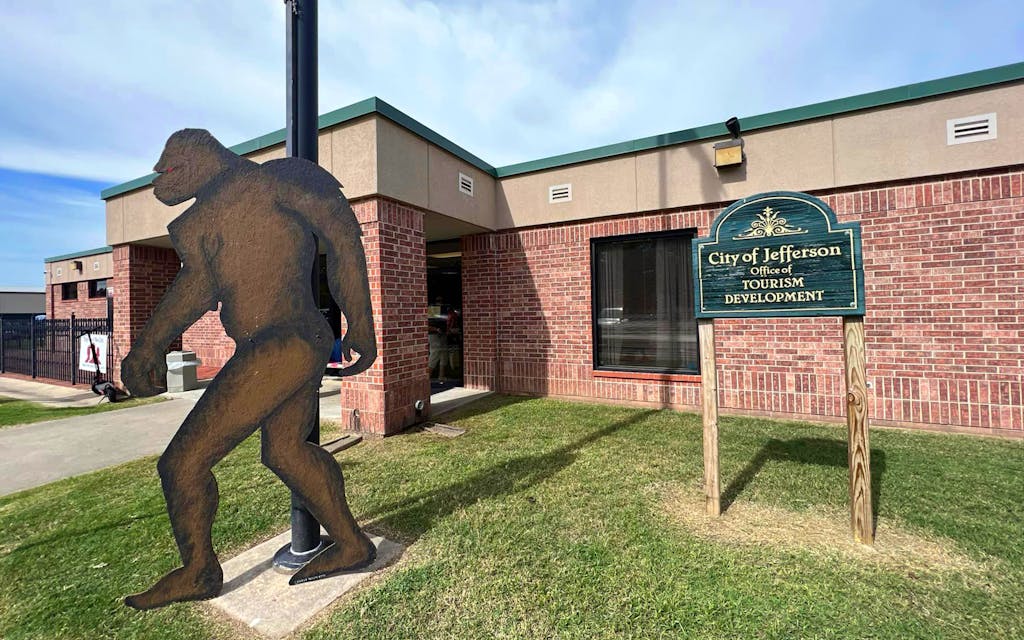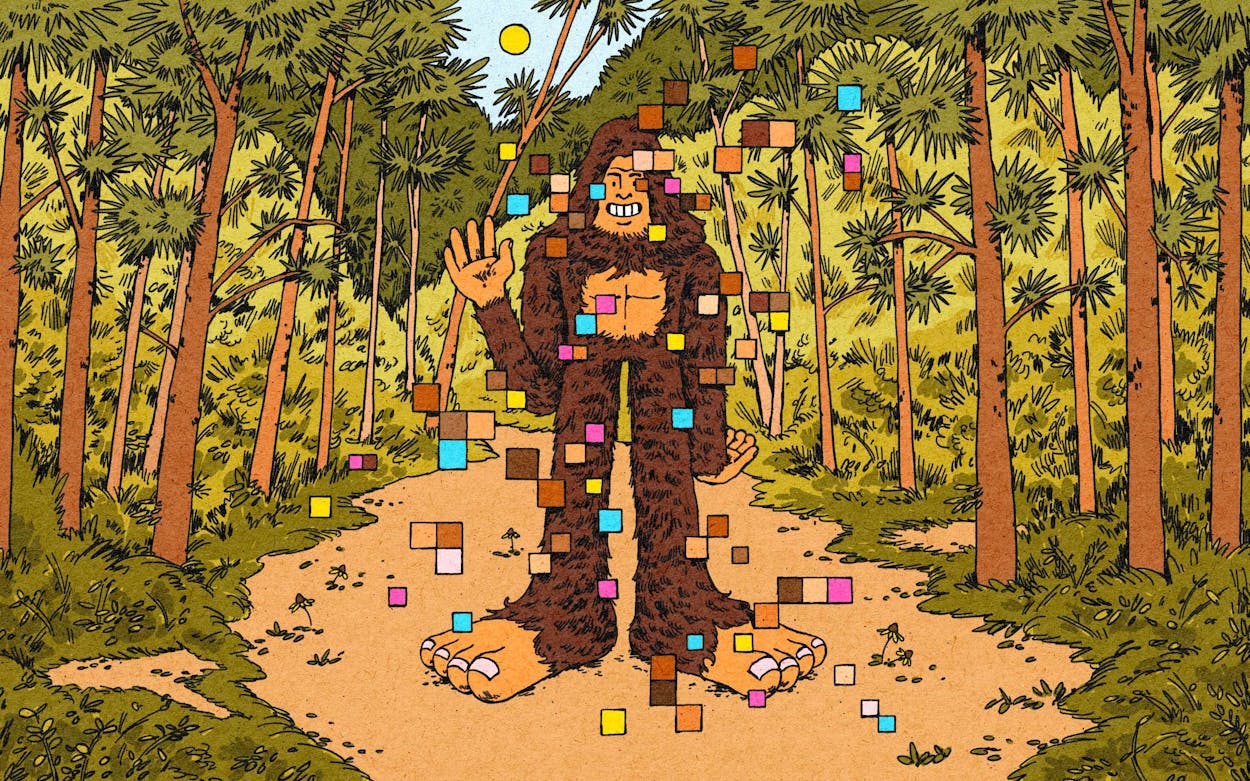The town of Jefferson, a twenty-minute drive from Caddo Lake, in East Texas, is the creepy-cute love child of Gilmore Girls’ Stars Hollow and True Blood’s Bon Temps. At first glance, Jefferson seems like an unlikely gathering place for those hunting the unknown. It is profoundly quaint: there is a Gone With the Wind museum, the shops are “shoppes,” the restaurants are “taverns” and “saloons,” and the antiques overfloweth. On a Saturday morning in October, the town has not yet woken up, and an orange cat suns itself in the middle of a brick-laid street in the middle of town. The previous night, however, walking back to my Airbnb in the dark from the evening’s saloon, Jefferson had me thoroughly spooked.
Craig Woolheater has held the annual Texas Bigfoot Conference for 23 years, often in Jefferson. His parents bought a bed-and-breakfast in town in 2000, and Woolheater hosted the conference’s early iterations there, with his parents catering—the first year, there was a pancake breakfast. Back in 2001, Woolheater recalls, there were only about three or four Bigfoot events nationwide each year. Now, he says, it seems like there’s one every weekend, some drawing thousands of visitors. His conference is more modest, typically accommodating between 200 and 250 guests in previous years.
Woolheater, a water conservation consultant, is tall and mighty but very soft-spoken. (He is also capable of great rage, he tells me, citing the parking situation after a Rolling Stones concert in Houston in 2019). He describes himself as a behind-the-scenes guy at the conference—not unlike Bigfoot himself. Woolheater became interested in Bigfoot after his own sighting in Central Louisiana in 1994, and he is glad to have created a community where those who have had encounters they cannot explain can share them without judgment. “We’ve had some oddballs,” he concedes. He remembers one man, a self-identified doctor, telling him his theory that Bigfoot was the offspring of “lonely mountain men” and bears. “That’s a new spin on getting your back scratched up,” he quips, adding that having seen The Revenant, he finds such a romance improbable.

But when I arrive at the visitors center on Saturday, the conferencegoers seem more oddball curious than themselves odd (perhaps disregarding a man in a Bigfoot costume greeting guests by the door). A woman in a striped T-shirt and glasses, who moved to Jefferson from Houston three years ago, tells me this is her first time at the conference. “In Jefferson we celebrate everything,” she says. “That’s why I love it.” She notes that Jefferson is just an hour away from Fouke, Arkansas, which holds the Fouke Monster Festival, co-organized by Woolheater, every year. (Fouke is pronounced “Fowk,” to my disappointment.)
As 10 a.m. approaches, I take a seat in the conference hall and am soon joined by an older gentleman who sits with his hands propped, one over the other, on the newel of a cane in front of him. He and his son have been attending the conference for eighteen years, he says. They’re Discovery Channel men, and he used to consider himself an investigator but is now a more passive hobbyist. I ask him if he’s ever had a sighting. No, he says, “but I smelt one once.”
At a table toward the front of the hall, three sisters sit oldest to youngest in matching T-shirts. The middle sister explains that when she was four years old, she woke and saw a massive hand—so large that it couldn’t be human—pressed up against her window. Across the table, a woman who traveled to the event with her husband from Pittsburg, about an hour to the northwest, tells her own story. When she was seventeen, she says, she woke one night to barking. Her dog had been cornered on the outside of the wall next to her bed by something very large. The dog was a blue heeler, her husband interjects with the confidence of a spouse who has heard a story many times, and “wasn’t scared of nothing.” Whatever was out there that night was big.
I was not drawn to the Texas Bigfoot Conference by an encounter of my own, though I have seen enough unsettling activity in the woods to believe—at least, when I’m alone, walking back to a campsite after dark—that something is out there. I came in large part because there are many species in the United States that we have not yet been formally introduced to—Rice University entomologists discover new wasps at about the same rate I discover new freckles on my arms—and I see value in considering the ethical questions that surround hypothetical new species (to say nothing of extinct but previously unknown species, which Texas scientists are still discovering at a rapid clip: this year’s finds include an ancient beaver named after Buc-ee’s and a dog-size dinosaur whose jawbone was spotted by a Perot Museum volunteer). I was also interested in how the idea of “proof” might have changed with the advancement of artificial intelligence and the proliferation of misinformation online. When everything we see online is unbelievable, what future is there for a community built around the unbelievable?
The first two speakers at the conference are temperate in their Bigfoot-ism. Wildlife enthusiast Shelly Covington-Montana starts the day with a presentation on the basics of tracking and collecting samples from animals, followed by a talk from wildlife journalist Chester Moore, who runs a conservation-based youth mentorship program, Higher Calling Wildlife. He also hosts two podcasts, one called Higher Calling Wildlife and the other called Dark Outdoors. Moore tells me later that he stopped lecturing on Bigfoot several years ago because he “had nothing to add to the conversation.” Instead, his presentation concerns other unusual critters allegedly spotted in Texas, ranging from the merely rare (black coyotes) to the nearly extinct (red wolves). He also discusses more dubious species, such as “black longtails,” his term for cats often assumed to be “black panthers.” Though melanistic leopards and jaguars have been documented elsewhere, Moore believes that in Texas, the majority of these felines are actually domestic cats. (Some of them, he has written, may be jaguarundis, a species with no verified sightings in Texas since 1986—yet.) On a projector, he shows a dashcam image of a feral hog with long, kangarooesque feet crossing a road, and another of a macaque in the Frio County town of Dilley. “If these guys”—snow monkeys—“can adjust to South Texas, what else can?” he asks. “America’s got a lot of crazy s—.”
Around lunchtime, the speakers become less measured in their Bigfoot talk. During the fifteen-minute break after Moore’s presentation, some visitors had crowded a food truck parked outside and while others swarmed Moore with photos of unusual cats they’d seen in their neighborhoods. But now they drift back to their seats in the conference hall as Michael Mayes, a schoolteacher and author of Valley of the Apes: The Search for Sasquatch in Area X, takes the lectern. He plays audio that he and other investigators gathered from Area X, a remote section of the Ouachita Mountains in Oklahoma. The sound of the woods at night fills the room like white noise. We hear a whistle. “Yeah, they whistle,” Mayes narrates. Then there is a loud grunt, and a few seconds later an earthshaking thump that makes a woman at my table jump. This, Mayes explains, is a rock throw, a territorial tactic of so-called wood apes. The audience—even a trio of listeners who had been taking videos and smirking at one another during introductions—is quiet and rapt.
Mayes introduces a question that has preoccupied investigators for decades but has become more complicated in recent years: What will it take for people to believe Bigfoot exists? Mayes believes a specimen must be collected—the world will have to see a Bigfoot, a “holotype,” to accept that they exist—but he has changed his mind about who should do the collecting. He used to think, and even hope, that it might be him, but now he feels that “citizen scientists” such as himself should focus on gathering photographic evidence and leave the job of bagging Bigfoot to experts with institutional affiliations. If just anyone hauled in a Bigfoot carcass, he says, the blowback from animal rights groups and beyond would be ruinous.
The next speaker, Daryl Colyer, focuses his entire presentation on the question: Should we kill Bigfoot? Colyer had asked an AI chatbot about the implications of collecting a Bigfoot holotype. AI warned against it: the public outcry if Bigfoot were to be killed, the service replied to Colyer, would be swift and extreme—particularly if the species does bear a resemblance to humans, as many investigators believe. Social media would compound the rage, Colyer explains, and the person who felled the first Bigfoot would be ruined. (I think of Walter Palmer, who in slaying Cecil the lion in 2015 became the most hated dentist in America, which is saying something.) What if, Colyer asks, Bigfoot were declared endangered and retroactive laws against hunting were applied? And what if the holotype turned out to be the last of its species? Colyer, like Mayes, believes that someone will have to kill a Bigfoot, but it won’t be him, either.
It can seem like our nation has arrived at a moment of incredible intellectual flexibility. On one hand, this has created fertile ground for the conspiracy theories that have poisoned social media and turned formerly quirky relatives into menaces. On the other, better hand, America’s gullet is open to possibilities we might not have considered ten years ago—with the right evidence. In a hearing before Congress in July, for instance, United States Air Force officer and former intelligence officer David Grusch testified that the U.S. government possesses nonhuman “biologics” recovered from crash sites of unidentified anomalous phenomena, formerly UFOs. In the course of a day, many Americans swiftly accepted the existence of extraterrestrials. (“UFOs are especially hot right now,” Woolheater tells me.) Why not Bigfoot?
But this is also an era characterized by ambient suspicion and misinformation. Earlier in October, a video of an apparent Bigfoot, allegedly taken from a train in Colorado, had gone viral. I saw the video on Twitter and barely registered it. My mind immediately zooped through the disappointing possibilities—a prankster in a furry costume, AI, a promotional gimmick—and I disregarded what I was seeing. (Woolheater, who approaches all reports with an open mind, notes that there have been sightings in the area around Silverton, Colorado, where the video was apparently taken, but adds that a company based nearby that sells trailers, Sasquatch Expedition Campers, includes a photo of someone in a Bigfoot costume on its website.) Social media has long been saturated with fraudulent images, and as AI improves, images and videos are being faked with increasing accuracy. Sensational online images have always warranted skepticism; now the burden of proof is even higher.
A dead holotype has not always been necessary to prove the existence of a species. The next speaker, primatologist and star of the Travel Channel show Expedition Bigfoot Mireya Mayor, has experience discovering new species: she was part of an expedition that found three new species of mouse lemur. (Prior to pivoting to primatology and television, Mayor was a Miami Dolphins cheerleader, and her presentation is flawless, each moment well choreographed to corresponding high-budget video footage and photography from her travels.) Mayor proposes that the mouse lemur could be an example of how photos, coupled with samples of DNA and other material, can suffice. She does note that some mouse lemurs are now in captivity—a feat slightly more difficult with Bigfoot, who many believe is extremely large and, if the rock throws are any indication, can be violent when feeling fussy.
Mayor’s comment comes up the next day among the remaining speakers over a celebratory lunch at Big Pines Lodge. The outdoor seating area is perched on the banks of Caddo Lake, and Sunday boaters zoom back and forth past the balding cypress trees hung with Spanish moss. A Staffordshire terrier and a pit bull that had been splayed in the parking lot before the restaurant opened now amiably wander among the diners. As plates piled with blackened catfish and fries sail out of the kitchen, Michael Mayes and Moore pass their phones back and forth across the table, comparing photos of strange animals that have been sent to them. Mayor and the final speaker, Matt Pruitt, who in his presentation described his Sisyphean journey to prove the validity of police dashcam footage of a possible Bigfoot in Georgia, had left earlier in the morning.
Mouse lemurs, the others speakers agree, are perhaps not the ideal point of comparison for Bigfoot, because the existence of lemurs was not in question when Mayor discovered her species. There is no real comparison for Bigfoot. Nor have other critters, Colyer points out, been made synonymous with fraud by generations of pranksters. “What these other things don’t have that the Sasquatch has,” he goes on, “is con artists, charlatans, hoaxers, who for whatever reason want to get in on this and play games. And it makes it tough for those of us who really have a keen interest, who have actually seen it. It makes it tough for us to get heard.” (A man named Rick Dyer actually claimed to have hunted a Bigfoot in San Antonio a decade ago; he had made a similar claim in 2008, and the alleged holotype reportedly turned out to be a rubber ape costume.)
In his presentation the previous day, Colyer had suggested that institutions such as the Smithsonian might be better prepared than individuals to manage a wood ape holotype, because they have more resources with which to defend themselves from criticism and legal consequences. Institutional credibility was, after all, the turning point for “nonhuman biologics.” But as I drive home, I wonder whether such support would be enough to counteract decades of fraud, or whether Bigfoot, should he really, truly roam, is a casualty of an age of mistrust. Maybe he likes it that way.








